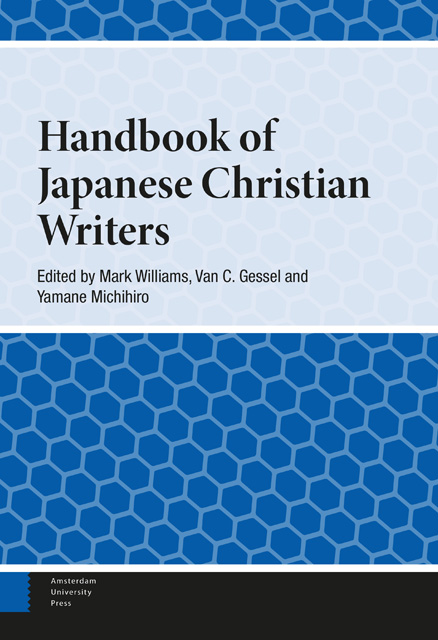Book contents
- Frontmatter
- Contents
- Contributors
- Abbreviations
- Preface
- Introduction
- 1 Prophet of the Inner Life: Kitamura Tōkoku
- 2 Shimazaki Tōson and Christianity: When the Cherries Ripen in the Taishō Period
- 3 Arishima Takeo and Christianity
- 4 Akutagawa Ryūnosuke: A Christian Life
- 5 Incarnation of the Christian Faith in the Poetry of Yagi Jūkichi
- 6 Hori Tatsuo: The Cross Dyed in Bloody Red and the Little Gods of Ancient Times
- 7 Nagai Takashi on Divine Providence and Christian Self-Surrender: Towards a New Understanding of hansai
- 8 Dazai Osamu: His Wrestle with the Bible
- 9 Shiina Rinzō: His Two Visages
- 10 From out of the Depths: Shimao Toshio’s Literary Response to Adversity
- 11 Yasuoka Shōtarō and Christianity: From Postwar “Emptiness” to Religious Longing
- 12 Miura Ayako and the Human Face of Faith
- 13 Endō Shūsaku and the Compassionate Companionship of Christ
- 14 Ogawa Kunio: Renewal of Faith and Identity in His seishomono (Bible Stories)
- 15 Kaga Otohiko: In Search of What Lies Beyond Death
- 16 Sono Ayako: Amor Vincit Omnia
- 17 Takahashi Takako: Drawing Closer to God Through Literature
- Index
- Index of titles
9 - Shiina Rinzō: His Two Visages
Published online by Cambridge University Press: 09 June 2023
- Frontmatter
- Contents
- Contributors
- Abbreviations
- Preface
- Introduction
- 1 Prophet of the Inner Life: Kitamura Tōkoku
- 2 Shimazaki Tōson and Christianity: When the Cherries Ripen in the Taishō Period
- 3 Arishima Takeo and Christianity
- 4 Akutagawa Ryūnosuke: A Christian Life
- 5 Incarnation of the Christian Faith in the Poetry of Yagi Jūkichi
- 6 Hori Tatsuo: The Cross Dyed in Bloody Red and the Little Gods of Ancient Times
- 7 Nagai Takashi on Divine Providence and Christian Self-Surrender: Towards a New Understanding of hansai
- 8 Dazai Osamu: His Wrestle with the Bible
- 9 Shiina Rinzō: His Two Visages
- 10 From out of the Depths: Shimao Toshio’s Literary Response to Adversity
- 11 Yasuoka Shōtarō and Christianity: From Postwar “Emptiness” to Religious Longing
- 12 Miura Ayako and the Human Face of Faith
- 13 Endō Shūsaku and the Compassionate Companionship of Christ
- 14 Ogawa Kunio: Renewal of Faith and Identity in His seishomono (Bible Stories)
- 15 Kaga Otohiko: In Search of What Lies Beyond Death
- 16 Sono Ayako: Amor Vincit Omnia
- 17 Takahashi Takako: Drawing Closer to God Through Literature
- Index
- Index of titles
Summary
Shiina Rinzō can be seen as both a member of the Sengoha (postwar) literary coterie and that of “Christian writers.” These two categorizations are born from two of his pivotal life experiences: his awakening to literature in the form of his “Dosutoefusukii taiken” (Dostoevsky experience) in 1938, and to the Christian faith with his “fukkatsu taiken” (resurrection experience) in 1951. And these two experiences are closely linked to the image of “light” that pervades Shiina's entire oeuvre.
Introduction
Shiina Rinzō (1911–1973) had two different visages. One belonged to an author who was active on the front lines in the post-World War II literary scene as a representative of the Daiichiji Sengoha (the First Generation of Postwar Writers). His other visage was that of a formally baptized “Christian author” whose writings vividly displayed themes rooted in a Christian world view.
The First Generation of Postwar Writers refers to those authors who debuted in 1946– 1947 as members of “a group who began writing after the Second World War. Employing psychological and existential techniques in their works, they pursued such themes as war responsibility and the question of individual identity, centering on issues dealing with politics and literature” (Daijirin, 3rd ed.). After a memorable debut with “Shin’ya no shuen” (Midnight Banquet*) in February 1947, Shiina proceeded to write a series of provocative works. In 1956, following publication of Utsukushii onna (The Beautiful Woman), he received the “Geijutsu senshō Monbudaijin-shō” (Minister of Cultural Affairs art encouragement prize) for that and other works. He was active in many fields: in addition to novels, he wrote screenplays, television dramas and plays, thereby bolstering his solid position in the postwar literary world. Existential leanings are especially strong in Shiina's writings in each of these genres, as he continued to question what it means to be alive.
Turning to his role as a Christian writer, Shiina was baptized on Christmas Eve 1950 in a Protestant church. Beginning with his “resurrection experience” in 1951, he foregrounded his Christian faith; and, in his writings, including the essays treating his personal experiences of faith which were collected as Watashi no seisho monogatari (My Bible Stories, 1957), and the images of the resurrected Christ in The Beautiful Woman, his Christian faith was tightly interwoven into his literary works.
- Type
- Chapter
- Information
- Handbook of Japanese Christian Writers , pp. 154 - 169Publisher: Amsterdam University PressPrint publication year: 2022



